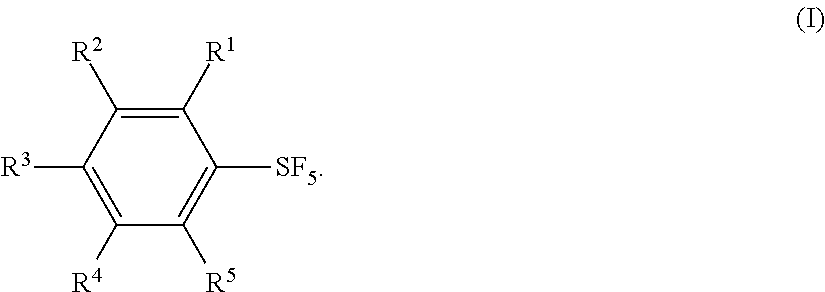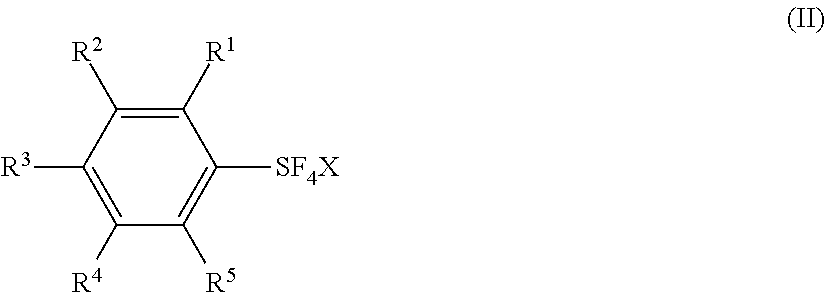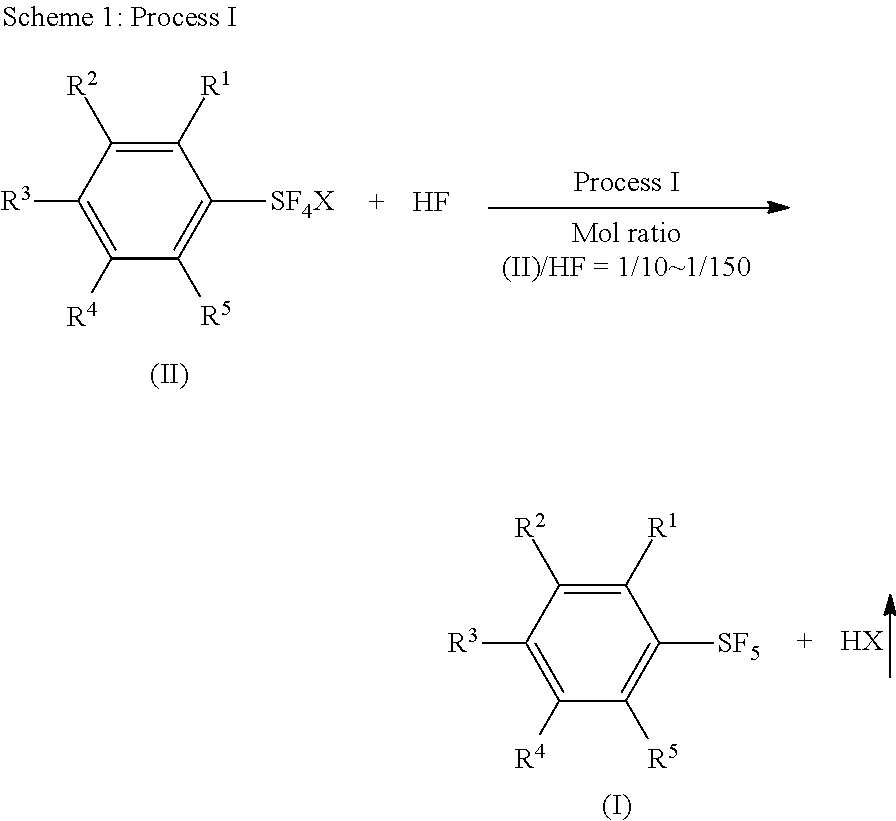Industrial Methods for Producing Arylsulfur Pentafluorides
a technology of arylsulfur pentafluoride and industrial methods, which is applied in the preparation of organic compounds, antineoplastic agents, organic chemistry, etc., can solve the problems of low yield, time and/or yield, and high cost, and achieve the effects of low yield, low cost, and high cos
- Summary
- Abstract
- Description
- Claims
- Application Information
AI Technical Summary
Benefits of technology
Problems solved by technology
Method used
Image
Examples
example 1
Synthesis of Phenylsulfur Pentafluoride by Reaction of Phenylsulfur Chlorotetrafluoride with Anhydrous Hydrogen Fluoride
[0085]
[0086]While N2 gas was flowed through a 250 mL fluoropolymer (FEP) vessel set with a condenser (made of fluoropolymer), the vessel was cooled in a bath of −11° C. A coolant (−25° C.) was flowed through the condenser. The vessel cooled at −11° C. was charged with 72.3 g (3.62 mol) of anhydrous hydrogen fluoride which was cooled at −20° C. Into the vessel, 35.0 g (0.152 mol) of phenylsulfur chlorotetrafluoride (this purity was 96 wt % and the other 4 wt % was phenylsulfur trifluoride) was added over 90 min through a syringe using a syringe pump. The molar ratio of phenylsulfur chlorotetrafluoride and hydrogen fluoride was 1 / 24. After the addition, the reaction mixture was stirred at −10° C. for 20 hours. After that, the reaction mixture was warmed to 25° C. and hydrogen fluoride was removed at the temperature under atmospheric pressure. The residue was mixed wi...
example 12
Synthesis of Phenylsulfur Pentafluoride by Reaction of Phenylsulfur Chlorotetrafluoride with Anhydrous Hydrogen Fluoride in the Presence of K+F−.HF Added as an Additive
[0089]
[0090]A dried 125 mL fluoropolymer (FEP) vessel was flowed with N2 gas and charged with 48.0 g (2.40 mmol) of liquid anhydrous hydrogen fluoride which was cooled at −20° C. The vessel was set with a condenser (made of fluoropolymer) and a thermometer, and cooled in a bath of −20° C. A coolant (−15° C.) was flowed through the condenser. Into the vessel, 8.6 g (0.11 mol) of KF.HF was added. While the mixture was warmed to +15° C., 22.1 g (96.2 mmol) (purity 96 wt % and the other was phenylsulfur trifluoride) of phenylsulfur chlorotetrafluoride was added to the mixture over 1 hour through a syringe. The temperature of the reaction mixture was 3.4° C. and 13.6° C. at the starting point and completing point of the addition, respectively. After the addition, the reaction mixture was stirred at 15° C. for 18 h. After t...
example 20
Synthesis of Arylsulfur Pentafluoride (I) by Reaction of Arylsulfur Halotetrafluoride (II) with anhydrous hydrogen fluoride in the presence of a non-fluoride salt
[0095]
[0096]Liquid anhydrous hydrogen fluoride (61 g, 3.05 mol) was put in a dried 125 mL fluoropolymer vessel in the same way as in Example 12. The vessel was then set with a condenser (made of fluoropolymer) and a thermometer, and cooled in a bath of −20° C. Sodium acetate (9.0 g, 0.11 mol) was added portion by portion into a stirred liquid of hydrogen fluoride in the vessel. The mixture was homogenious. A coolant (−15° C.) was flowed through the condenser and the bath temperature was raised to −10° C. Phenylsulfur chlorotetrafluoride (23.4 g, purity 95 wt %, 0.101 mol) was added to the mixture over 30 min through a syringe using a syringe pump. The temperature of the reaction mixture was −8° C. and −6° C. at the starting point and completing point of the addition, respectively. The bath temperature was then raised to +5°...
PUM
| Property | Measurement | Unit |
|---|---|---|
| temperature | aaaaa | aaaaa |
| temperature | aaaaa | aaaaa |
| temperature | aaaaa | aaaaa |
Abstract
Description
Claims
Application Information
 Login to View More
Login to View More - R&D
- Intellectual Property
- Life Sciences
- Materials
- Tech Scout
- Unparalleled Data Quality
- Higher Quality Content
- 60% Fewer Hallucinations
Browse by: Latest US Patents, China's latest patents, Technical Efficacy Thesaurus, Application Domain, Technology Topic, Popular Technical Reports.
© 2025 PatSnap. All rights reserved.Legal|Privacy policy|Modern Slavery Act Transparency Statement|Sitemap|About US| Contact US: help@patsnap.com



